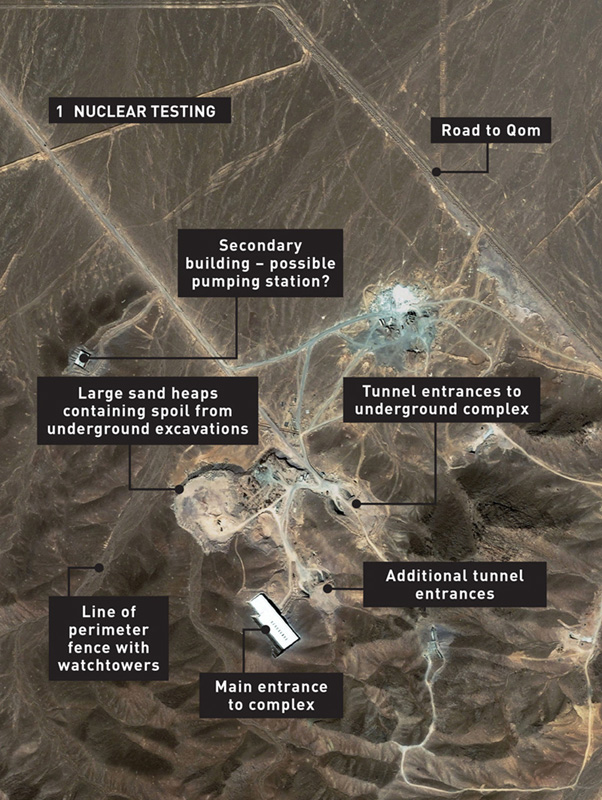
76 Fordo uranium enrichment plant
LOCATION Qom Province, northern Iran
NEAREST POPULATION HUB Qom
SECRECY OVERVIEW Operations classified: uranium-processing facility at the center of international concern.
The nuclear facility at Fordo is built into a mountainside, not far from the sacred city of Qom. Iran only admitted to the facility’s existence in September 2009, insisting that it was purely for civilian uses. The international community’s fears that its purpose was not necessarily peaceful were seemingly confirmed by the International Atomic Energy Agency (IAEA) in January 2012.
That month, the IAEA announced that the plant had begun production of uranium enriched up to 20 percent, which is regarded as a milestone on the journey toward weapons-grade enrichment. Iran, meanwhile, holds that its enrichment program is guided not by the quest for nuclear weapons (a US intelligence report in 2007 concluded that its previous nuclear armaments program ceased in 2003) but that enriched uranium is needed for fuel in research reactors and in the production of cancer-fighting isotopes.
Western intelligence agencies had first identified the Fordo facility in September 2009, at which point Tehran admitted that its construction had been underway since 2007 (though the IAEA subsequently suggested a more likely date of 2006). To fulfill its duties to the IAEA, Tehran should have volunteered details much earlier than it did.
Carved into a mountain (thus reducing the possibility of damaging air strikes), the facility is heavily fortified and located close to military installations armed with anti-aircraft defenses and weapons silos. Iran claims these are necessary precautions to protect a legitimate project from US or Israeli attacks.
The nearby settlement of Fordo is claimed by some to have lost a greater percentage of its population than any other village during the war with Iraq that raged from 1980 to 1988. Quite what its inhabitants make of being at the center of a new dispute with such militaristic undertones can only be imagined. Fordo lies about 30 kilometers (19 miles) north of Qom, itself about 150 kilometers (90 miles) southwest of Tehran and one of the principal places of learning for Shi’a Muslims, as well as an important site of pilgrimage.
Iran’s nuclear program has been used alternately as a threat and a bargaining chip in the long-running war of words between Tehran and the West. While the government of President Mahmoud Ahmadinejad had previously told IAEA inspectors that Fordo was intended to produce uranium enriched to 5 percent (a level commonly used in nuclear power production), it announced in June 2011 that it was working on 20 percent enrichment, taking over enrichment previously undertaken at the Natanz plant in Isfahan Province.
Fordo is one of a number of sites within the country causing concern to the wider world. Others include the Bushehr power station (begun in 1974 as a joint project with West Germany, abandoned after the Islamic revolution of 1979, but revived in the 1990s with Russian assistance), a heavy water plant at Arak (scheduled to operate from 2013), a uranium mine at Gachin (opened in 2004) and, perhaps most ominously, an area of the Parchin munitions center identified as a possible nuclear weapons development lab.

HIGH STAKES Iran’s President Mahmoud Ahmadinejad (third from right) received a tour of the nuclear power plant at Bushehr in 2006. Since coming to power in 2005, Ahmadinejad has fiercely defended Iran’s right to run a peaceful nuclear power program.
Suspicions over Iran’s nuclear intentions have been heightened by the country’s reluctance to cooperate with the IAEA’s program of inspections, to which it is obliged to submit as a signatory of the Nuclear Non-Proliferation Treaty. In November 2011, the IAEA reported that Iran had undertaken work “relevant to the development of a nuclear explosive device,” though it stopped short of confirming whether or when the country would be capable of producing a working bomb. As a result of its refusal to comply with IAEA rules, Tehran has been hit by a variety of sanctions imposed by the UN, the US and the EU.
Intermittently, Iran has claimed no interest in developing nuclear weapons capabilities, insisting that it is merely exercising its legal right to develop a nuclear program for civilian use. Ahmadinejad, never one to shy away from a scuffle with the West, has been quoted as saying: “We do not need an atomic bomb. The Iranian nation is wise. It won’t build two atomic bombs while you [the US] have 20,000 warheads.” Elsewhere, Iran’s spiritual head and Supreme Leader, Ayatollah Ali Khamenei, has reportedly issued a fatwa against nuclear weapons.
But like North Korea, Iran has realized that retaining some mystery about its nuclear capabilities can serve as a useful bargaining chip at the international negotiating table. And what better way to retain that air of mystery than by hiding key facilities inside mountains?

1 NUCLEAR TESTING This image from DigitalGlobe’s QuickBird satellite shows the state of the Fordo site in 2009, with several tunnel entrances clearly visible.